Localizing Indicators of SDG11 for an Integrated Assessment of Urban Sustainability—A Case Study of Hainan Province
Abstract
:1. Introduction
2. Study Area and Data
2.1. Study Area
2.2. Obtaining Data on SDG11 in Hainan
3. Construction and Research Method of the Index System
3.1. Remote Sensing Data Preprocessing
3.2. Urban Sustainable Development Index System Based on SDG11
3.3. Methods
3.3.1. Single Indicator Score
3.3.2. Single Indicator Trend
3.3.3. Comprehensive Evaluation Method
4. Results and Analysis
4.1. Single Index Ranking and Change Trend Analysis
4.2. Analysis of Temporal Evolution and Spatial Patterns
4.3. Spatiotemporal Clustering Analysis
5. Discussion
6. Conclusions
Author Contributions
Funding
Data Availability Statement
Acknowledgments
Conflicts of Interest
References
- United Nations General Assembly. Transforming Our World; The 2030 Agenda for Sustainable Development; United Nations: New York, NY, USA, 2015; Available online: https://sustainabledevelopment.un.org/post2015/transformingourworld (accessed on 20 April 2020).
- Elmqvist, T.; Andersson, E.; Frantzeskaki, N.; McPhearson, T.; Olsson, P.; Gaffney, O.; Takeuchi, K.; Folke, C. Sustainability and Resilience for Transformation in the Urban Century. Nat. Sustain. 2019, 2, 267–273. [Google Scholar] [CrossRef]
- Acuto, M.; Parnell, S.; Seto, K.C. Building a Global Urban Science. Nat. Sustain. 2018, 1, 2–4. [Google Scholar] [CrossRef]
- UN-Habitat. A Guide to Assist National and Local Governments to Monitor and Report on SDG Goal 11+ Indicators, Online Edition. Available online: https://www.local2030.org/library/60/SDG-Goal-11-Monitoring-Framework-A-Guide-to-Assist-National-and-Local-Governments-to-Monitor-and-Report-on-SDG-Goal-11-indicators.Pdf (accessed on 10 January 2021).
- Habitat III. The New Urban Agenda. Available online: https://uploads.habitat3.org/hb3/NUA-English.Pdf (accessed on 17 June 2016).
- Messerli, P.; Murniningtyas, E. Global Sustainable Development Report 2019: The Future Is Now Science for Achieving Sustainable Development; United Nations: New York, NY, USA, 2019. [Google Scholar]
- Sachs, J.D.; Schmidt-Traub, G.; Mazzucato, M.; Messner, D.; Nakicenovic, N.; Rockström, J. Six Transformations to Achieve the Sustainable Development Goals. Nat. Sustain. 2019, 2, 805–814. [Google Scholar] [CrossRef]
- Ministry of Foreign Affairs of the People’s Republic of China. China’s Position Paper on Implementing the 2030 Agenda for Sustainable Development. Available online: https://www.fmprc.gov.cn/web/ziliao_674904/zt_674979/dnzt_674981/qtzt/2030kcxfzyc_686343/t1357699.Shtml (accessed on 10 January 2021).
- Ministry of Foreign Affairs of the People’s Republic of China. The National Plan to Implement the 2030 Agenda for Sustain-Able Development. Available online: https://www.fmprc.gov.cn/web/ziliao_674904/zt_674979/dnzt_674981/qtzt/2030kcxfzyc_686343/P020161012715836816237.Pdf (accessed on 10 January 2021).
- The State Council of the People’s Republic of China. The Plan for the Construction of Innovation Demonstration Zones for the Implementation of the 2030 Agenda. Available online: http://www.gov.cn/zhengce/content/2016-12/13/content_5147412.Htm (accessed on 10 January 2021).
- Lynch, A.; LoPresti, A.; Fox, C. The 2019 US Cities Sustainable Development Report. 2019. Available online: https://s3.amazonaws.com/sustainabledevelopment.report/2019/2019USCitiesReport.Pdf (accessed on 10 January 2021).
- Lafortune, G.; Zoeteman, K.; Fuller, G.; Mulder, R.; Dagevos, J.; Schmidt, G. The 2019 SDG Index and Dashboards Report for European Cities. 2019. Available online: https://s3.amazonaws.com/sustainabledevelopment.report/2019/2019USCitiesReport.Pdf (accessed on 10 January 2018).
- Xu, Z.; Chau, S.N.; Chen, X.; Zhang, J.; Li, Y.; Dietz, T.; Wang, J.; Winkler, J.A.; Fan, F.; Huang, B.; et al. Assessing Progress towards Sustainable Development over Space and Time. Nat. Cell Biol. 2020, 577, 74–78. [Google Scholar] [CrossRef]
- Xu, X.; Gao, J.; Zhang, Z.; Fu, J. An Assessment of Chinese Pathways to Implement the UN Sustainable Development Goal-11 (SDG-11)—A Case Study of the Yangtze River Delta Urban Agglomeration. Int. J. Environ. Res. Public Health 2019, 16, 2288. [Google Scholar] [CrossRef] [Green Version]
- Ma, Y.; Ai, X. Evaluation of Sustainable Urbanization Development in Jilin Province Based on the 2030 Sustainable Development Goals. Sci. Geogr. Sin. 2019, 39, 487–495. [Google Scholar] [CrossRef]
- Guo, H.; Chen, F.; Sun, Z.; Liu, J.; Liang, D. Big Earth Data: A Practice of Sustainability Science to Achieve the Sustainable Development Goals. Sci. Bull. 2021, 66, 1050–1053. [Google Scholar] [CrossRef]
- Guo, H. Big Earth Data in Support of the Sustainable Development Goals. 2019. Available online: https://www.fmprc.gov.cn/mfa_eng/topics_665678/2030kcxfzyc/P020200927650108183958.Pdf (accessed on 25 April 2021).
- Geng, W.; Chen, J.; Zhang, H.P.; Xu, K. Task and Progress of Iaeg-Sdgs: Wggi in Monitoring Sdgs through a ‘Geographic Location’ Lens. ISPRS Int. Arch. Photogramm. Remote Sens. Spat. Inf. Sci. 2018, XLII-3, 385–390. [Google Scholar] [CrossRef] [Green Version]
- Anderson, K.; Ryan, B.; Sonntag, W.; Kavvada, A.; Friedl, L. Earth observation in service of the 2030 Agenda for Sustainable Development. Geo-Spat. Inf. Sci. 2017, 20, 77–96. [Google Scholar] [CrossRef]
- Chen, J.; Peng, S.; Zhao, X.; Ge, Y.; Li, Z. Measuring regional progress towards SDGs by combining geospatial and statistical information. Acta Geod. Cartogr. Sin. 2019, 48, 473–479. [Google Scholar] [CrossRef]
- Xiao, W.; Mills, J.; Guidi, G.; Rodríguez-Gonzálvez, P.; Barsanti, S.G.; González-Aguilera, D. Geoinformatics for the Conservation and Promotion of Cultural Heritage in Support of the UN Sustainable Development Goals. ISPRS J. Photogramm. Remote Sens. 2018, 142, 389–406. [Google Scholar] [CrossRef]
- Kuffer, M.; Wang, J.; Nagenborg, M.; Pfeffer, K.; Kohli, D.; Sliuzas, R.; Persello, C. The Scope of Earth-Observation to Improve the Consistency of the SDG Slum Indicator. ISPRS Int. J. Geo-Inf. 2018, 7, 428. [Google Scholar] [CrossRef] [Green Version]
- Giezen, M.; Balikci, S.; Arundel, R. Using Remote Sensing to Analyse Net Land-Use Change from Conflicting Sustainability Pol-Icies: The Case of Amsterdam. ISPRS Int. J. Geo-Inf. 2018, 7, 381. [Google Scholar] [CrossRef] [Green Version]
- HPBS (Hainan Provincial Bureau of Statistics). Hainan Statistical Yearbook 2019. Available online: https://www.hainan.gov.cn/ (accessed on 25 April 2021).
- Liang, Y. Correlations Between Health-Related Quality of Life and Interpersonal Trust: Comparisons between Two Generations of Chinese Rural-to-Urban Migrants. Soc. Indic. Res. 2014, 123, 677–700. [Google Scholar] [CrossRef]
- Shi, G.; Chen, Z.; Bi, C.; Wang, L.; Teng, J.; Li, Y.; Xu, S. A Comparative Study of Health Risk of Potentially Toxic Metals in Urban and Suburban Road Dust in the Most Populated City of China. Atmos. Environ. 2011, 45, 764–771. [Google Scholar] [CrossRef]
- The People’s Government of Hainan Province. Statistical Yearbook. Available online: https://www.hainan.gov.cn/hainan/zfsj/xsj.Shtml (accessed on 25 April 2021).
- United Nations Statistics Division. SDG Indicators Metadata Repository. Available online: https://unstats.un.org/sdgs/metadata/files/SDG-Indicator-metadata.zip (accessed on 10 April 2021).
- Hainan Provincial Bureau of Statistics. Statistical Data. Available online: http://stats.hainan.gov.cn/Tjj/ (accessed on 25 April 2021).
- Google Earth Engine. Dataset. Available online: https://developers.google.com/earth-engine/datasets/ (accessed on 21 December 2019).
- Atmospheric Composition Analysis Group. China Regional Estimates (V4.CH.03). Available online: http://fizz.phys.dal.ca/~atmos/martin/?Page_id=140 (accessed on 25 April 2021).
- Chen, J.; Gao, M.; Cheng, S.; Hou, W.; Song, M.; Liu, X.; Liu, Y.; Shan, Y. County-Level CO2 Emissions and Sequestration in China During 1997–2017. Sci. Data 2020, 7, 1–12. [Google Scholar] [CrossRef]
- UN. United Nations Population Division World Urbanization Prospects: The 2018 Revision. Available online: https://population.un.org/wup/ (accessed on 9 May 2020).
- Sun, Z.; Xu, R.; Du, W.; Wang, L.; Lu, D. High-Resolution Urban Land Mapping in China from Sentinel 1A/2 Imagery Based on Google Earth Engine. Remote Sens. 2019, 11, 752. [Google Scholar] [CrossRef] [Green Version]
- Jiang, H.; Sun, Z.; Guo, H.; Xing, Q.; Du, W.; Cai, G. A Standardized Dataset of Built-up Areas of China’s Cities with Populations over 300,000 for the Period 1990–2015. Big Earth Data 2021, 1–24. [Google Scholar] [CrossRef]
- Rosenstock, T.S.; Lamanna, C.; Chesterman, S.; Hammond, J.; Kadiyala, S.; Luedeling, E.; Shepherd, K.; DeRenzi, B.; Van Wijk, M.T. When Less Is More: Innovations for Tracking Progress Toward Global Targets. Curr. Opin. Environ. Sustain. 2017, 26–27, 54–61. [Google Scholar] [CrossRef]
- Allen, C.; Nejdawi, R.; El-Baba, J.; Hamati, K.; Metternicht, G.; Wiedmann, T. Indicator-Based Assessments of Progress towards the Sustainable Development Goals (SDGs): A Case Study from the Arab Region. Sustain. Sci. 2017, 12, 975–989. [Google Scholar] [CrossRef]
- Chen, J.; Gao, M.; Ma, K.; Song, M. Different Effects of Technological Progress on China’s Carbon Emissions Based on Sustainable Development. Bus. Strat. Environ. 2020, 29, 481–492. [Google Scholar] [CrossRef]
- United Nations Statistics Division. The Complete Set of Metadata for Indicators. Available online: https://unstats.un.org/sdgs/metadata/files/SDG-Indicator-metadata.Zip (accessed on 10 June 2021).
- Jiang, H.; Sun, Z.; Guo, H.; Weng, Q.; Du, W.; Xing, Q.; Cai, G. An Assessment of Urbanization Sustainability in China Between 1990 and 2015 Using Land Use Efficiency Indicators. NPJ Urban Sustain. 2021, 1, 1–13. [Google Scholar] [CrossRef]
- Sachs, J.; Schmidt-Traub, G.; Kroll, C.; Lafortune, G.; Fuller, G. Sustainable Development Report 2019; Bertelsmann Stiftung and Sustainable Development Solutions Network: New York, NY, USA, 2019; Available online: https://s3.amazonaws.com/sustainabledevelopment.report/2019/2019_sustainable_development_report.pdf (accessed on 10 June 2021).
- United Nations Statistics Division. Sustainable Development Goals Progress Chart 2021. Available online: https://unstats.un.org/sdgs/report/2021/progress-Chart-2021.Pdf (accessed on 10 June 2021).
- United Nations Statistics Division. Sustainable Development Goals Progress Chart 2020. Available online: https://unstats.un.org/sdgs/report/2020/progress-Chart-2020.Pdf (accessed on 10 June 2021).
- Dong, H.; Li, P.; Feng, Z.; Yang, Y.; You, Z.; Li, Q. Natural capital utilization on an international tourism island based on a three-dimensional ecological footprint model: A case study of Hainan Province, China. Ecol. Indic. 2019, 104, 479–488. [Google Scholar] [CrossRef]
- Yang, T.; Jin, Y.; Yan, L.; Pei, P. Aspirations and Realities of Polycentric Development: Insights from Multi-Source Data into the Emerging Urban Form of Shanghai. Environ. Plan. B Urban Anal. City Sci. 2019, 46, 1264–1280. [Google Scholar] [CrossRef]
- Haughton, G. Developing Sustainable Urban Development Models. Cities 1997, 14, 189–195. [Google Scholar] [CrossRef]
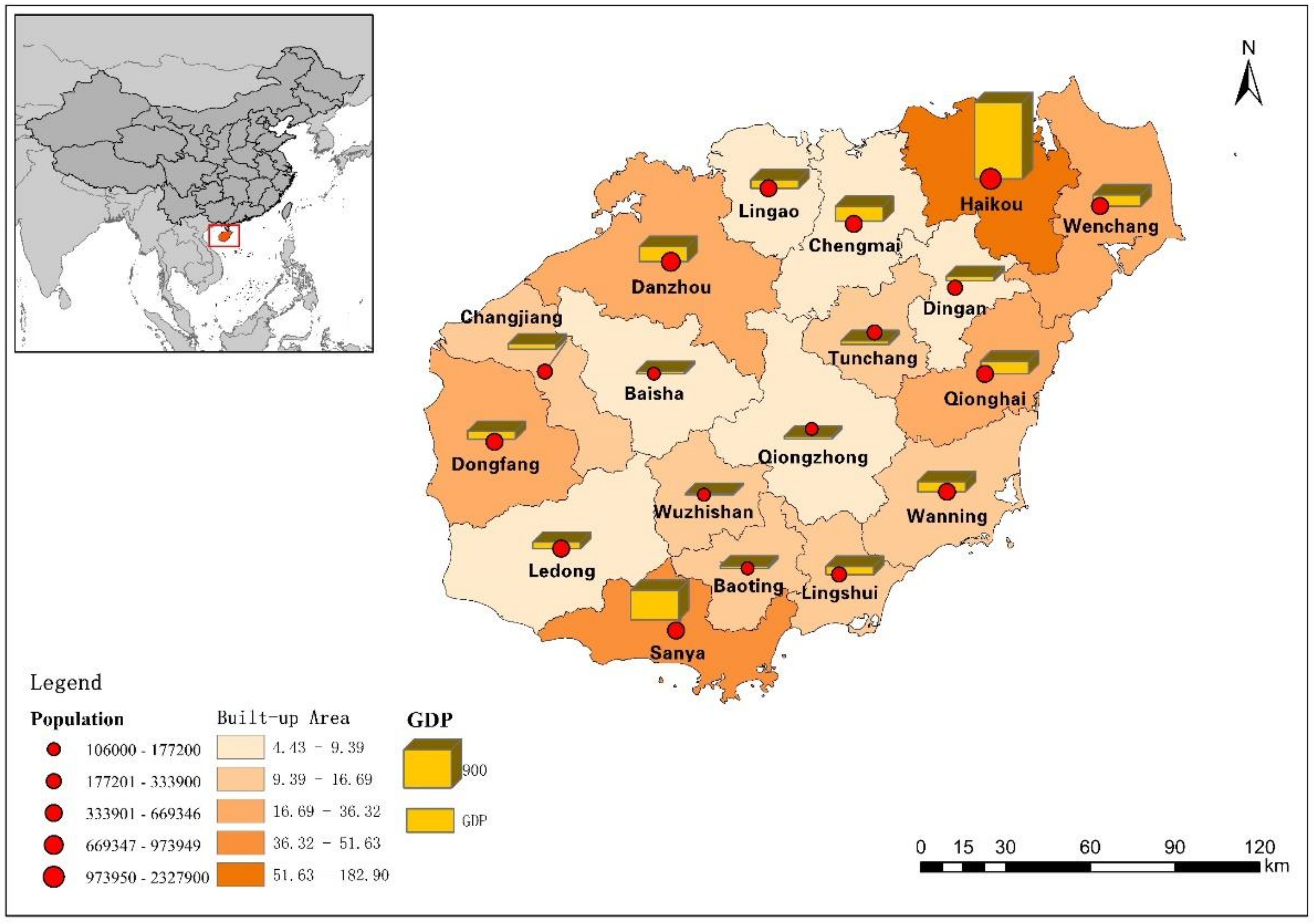
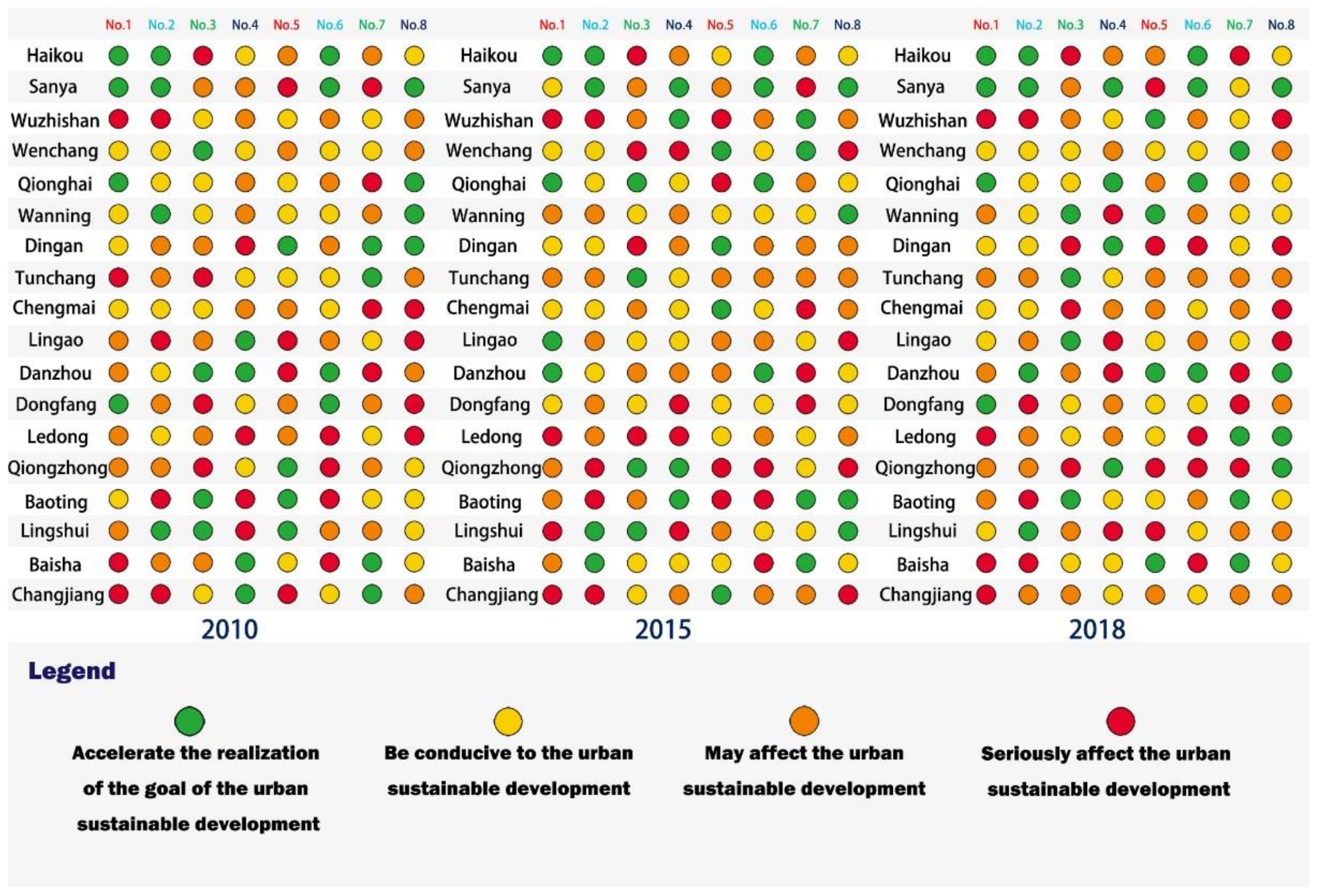
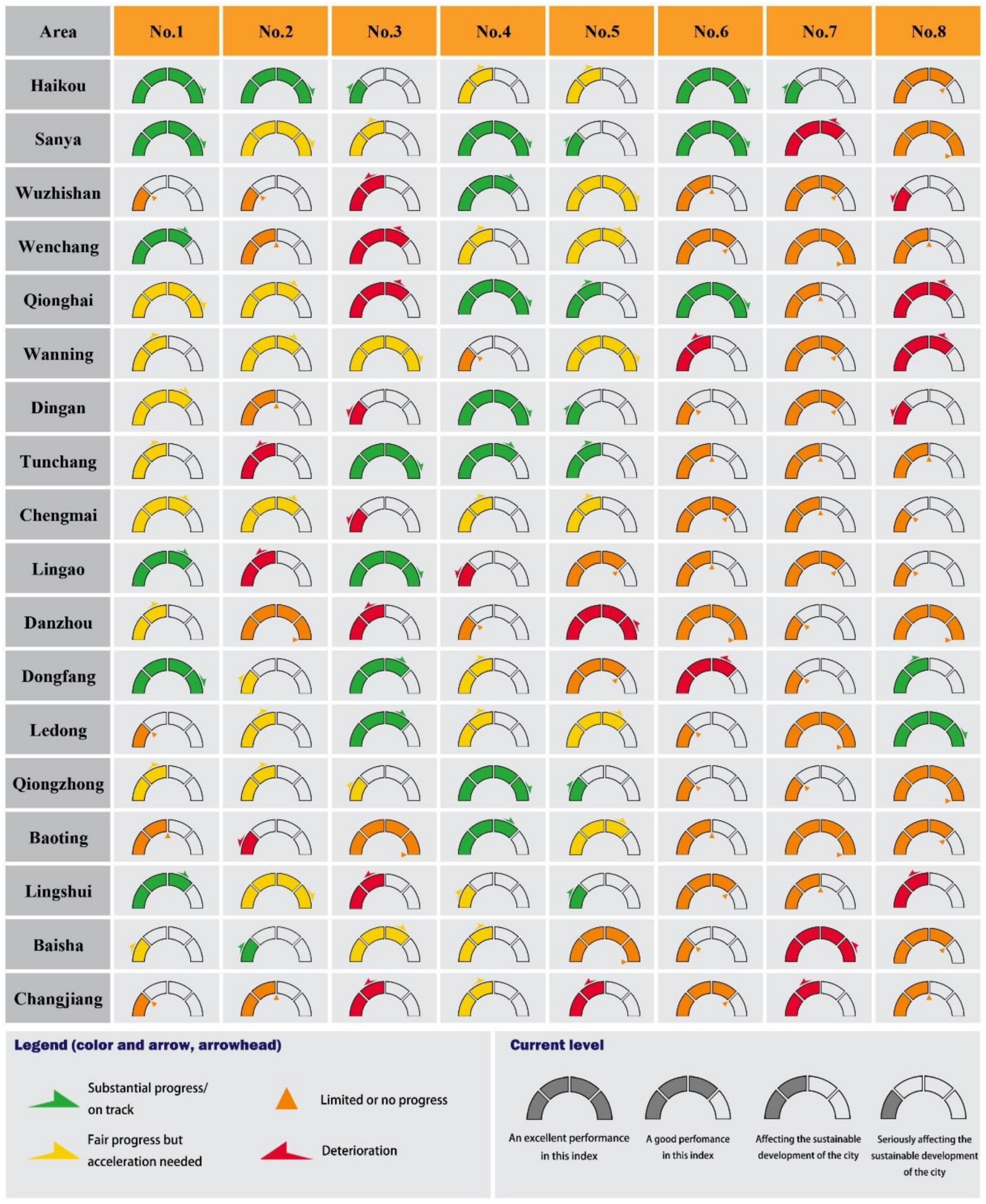
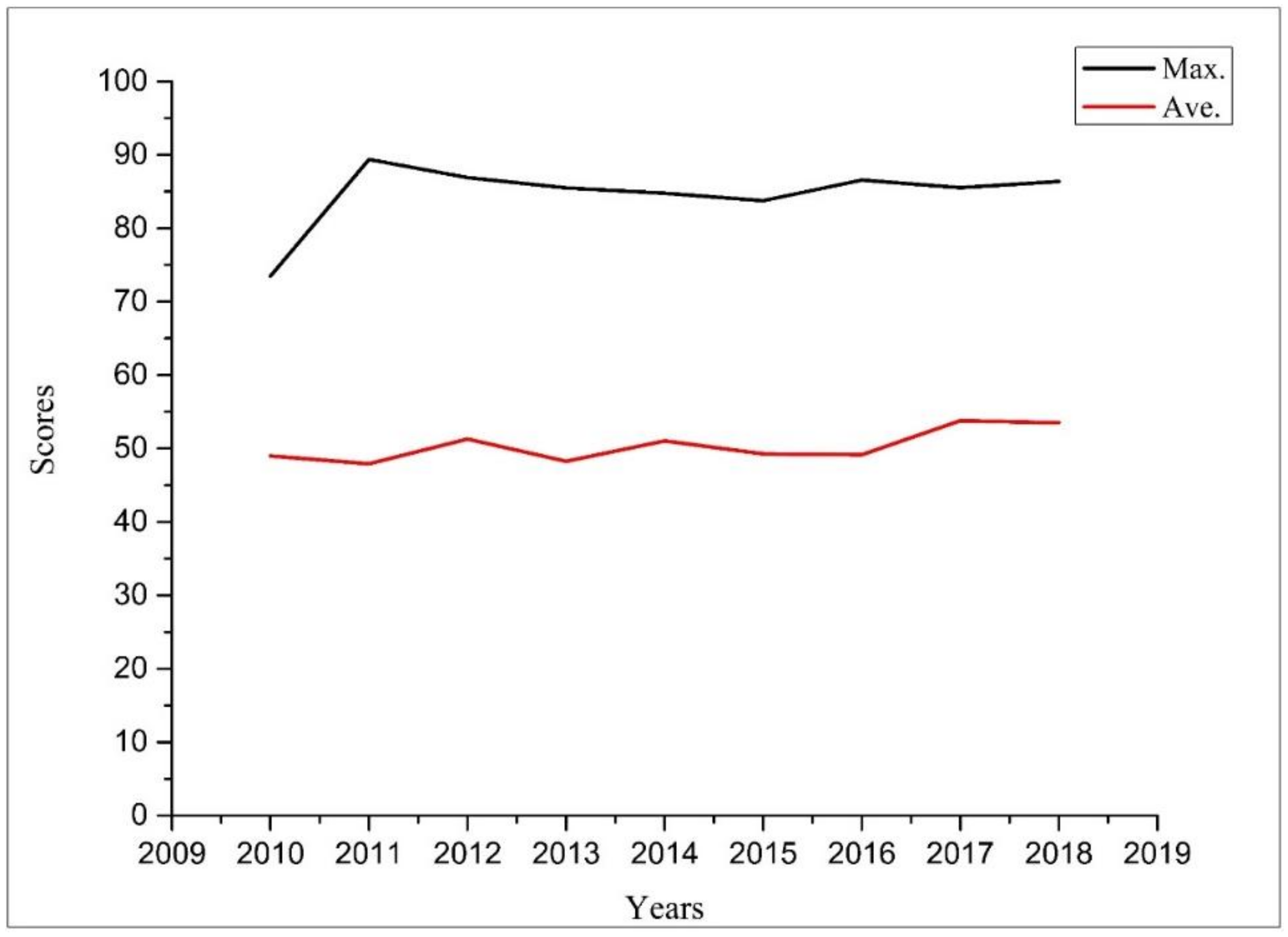

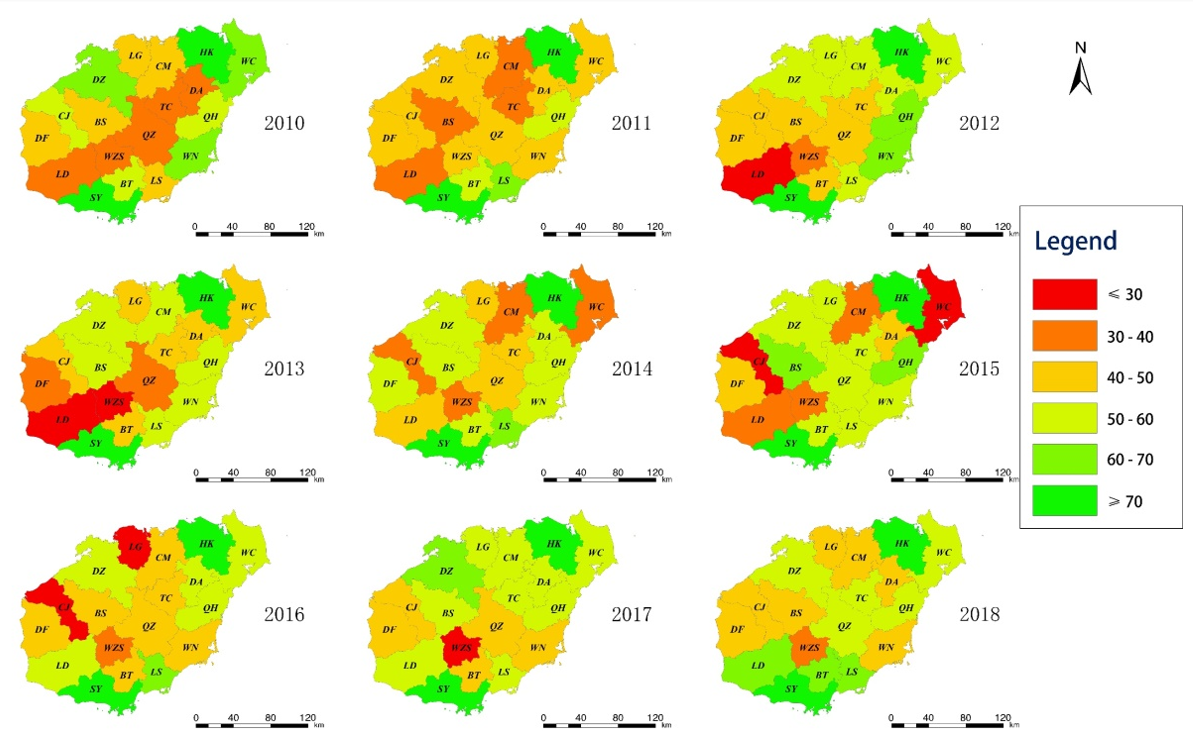

| Localized Indicators [1,28] | Data | Temporal Interval | Data Sources |
|---|---|---|---|
| 11.1.1—— (1) Rate of subsistence allowances (−) | Number of subsistence allowances | 2010–2018 | Statistical data [27] |
| 11.2.1—— (2) Passenger volume (+) | Passenger volume | 2010, 2015, 2020 | Statistical data [29] |
| 11.3.1—— (3) Ratio of land consumption rate to population growth rate (−) | Urban population and urban built-up area | 2010, 2015, 2020 | Remote sensing data (Sentinel-1A/210m time series data, WorldPop Global Project Population Data 100 × 100 m) [30] |
| 11.5.1—— (4) Fertility rate (−) | Total population of the city and the number of victims | 2010–2018 | Statistical data [27] |
| 11.5.1—— (5) Rate of dead and missing (−) | Total population of the city and the number of dead and missing | 2010–2018 | Statistical data [27] |
| 11.5.2—— (6) Direct economic loss in disasters to global GDP (−) | GDP and direct economic loss in disasters | 2010–2018 | Statistical data [27] |
| 11.6.1—— (7) Domestic garbage clearance volume (+) | Domestic garbage clearance volume | 2010–2018 | Statistical data [27] |
| 11.6.2—— (8) PM2.5 concentrations (−) | PM2.5 remote sensing data | 2010–2018 | Remote sensing data (AOD Data 1° × 1°) [31] |
| 11.6.2—— (9) CO2 emissions (−) | CO2 emissions | 2010–2018 | Ground monitoring data [32] |
| 11.6.2—— (10) NO2 concentration (−) | NO2 concentration | 2010–2018 | Statistical data [27] |
| 11.6.2—— (11) SO2 concentration (−) | SO2 concentration | 2010–2018 | Statistical data [27] |
| 11.7.1—— (12) Per capita park green area (+) | Per capita park green area | 2010–2018 | Statistical data [27] |
| SDG11 Indicators [1,28] | Localized Indicators | Method |
|---|---|---|
| 11.1.1 Proportion of urban population living in slums, informal settlements or inadequate housing | (1) Rate of subsistence allowances | [39] |
| 11.2.1 Proportion of population that has convenient access to public transport, by sex, age, and persons with disabilities | (2) Passenger volume | Statistics [27] |
| 11.3.1 Ratio of land consumption rate to population growth rate | (3) Ratio of land consumption rate to population growth rate | [39,40] |
| 11.5.1 Number of deaths, missing persons and directly affected persons attributed to disasters per 100,000 population | (4) Fertility rate | [39] |
| (5) Rate of dead and missing | [39] | |
| 11.5.2 Direct economic loss in relation to global GDP, damage to critical infrastructure, and number of disruptions to basic services, attributed to disasters | (6) Direct economic loss in disasters to global GDP | [39] |
| 11.6.1 Proportion of municipal solid waste collected and managed in controlled facilities out of total municipal waste generated by cities | (7) Domestic garbage clearance volume | Statistics [27] |
| 11.6.2 Annual mean levels of fine particulate matter (e.g., PM2.5 and PM10) in cities (population weighted) | (8) PM2.5 remote sensing data (9) CO2 emissions (10) NO2 concentration (11) SO2 concentration | Remote sensing data used to calculate the local average PM2.5 concentration [29]/statistics [27] |
| 11.7.1 Average share of the built-up area of cities that is open space for public use for all, by sex, age, and persons with disabilities | (12) Per capita park green area | Statistics [27] |
| Substantial Progress/on Track | Fair Progress but Acceleration Needed | Limited or No Progress | Deterioration | |
|---|---|---|---|---|
| 11.1.1 | ||||
| 11.2.1 | ||||
| 11.3.1 | ||||
| 11.5.1 | ||||
| 11.5.2 | ||||
| 11.6.1 | ||||
| 11.6.2 | ||||
| 11.7.1 |
| Year | 2010 | 2011 | 2012 | 2013 | 2014 | 2015 | 2016 | 2017 | 2018 |
|---|---|---|---|---|---|---|---|---|---|
| Moran’s I | 0.148 | 0.197 | 0.178 | 0.081 | −0.004 | −0.010 | 0.095 | 0.038 | −0.056 |
Publisher’s Note: MDPI stays neutral with regard to jurisdictional claims in published maps and institutional affiliations. |
© 2021 by the authors. Licensee MDPI, Basel, Switzerland. This article is an open access article distributed under the terms and conditions of the Creative Commons Attribution (CC BY) license (https://creativecommons.org/licenses/by/4.0/).
Share and Cite
Zhang, C.; Sun, Z.; Xing, Q.; Sun, J.; Xia, T.; Yu, H. Localizing Indicators of SDG11 for an Integrated Assessment of Urban Sustainability—A Case Study of Hainan Province. Sustainability 2021, 13, 11092. https://doi.org/10.3390/su131911092
Zhang C, Sun Z, Xing Q, Sun J, Xia T, Yu H. Localizing Indicators of SDG11 for an Integrated Assessment of Urban Sustainability—A Case Study of Hainan Province. Sustainability. 2021; 13(19):11092. https://doi.org/10.3390/su131911092
Chicago/Turabian StyleZhang, Chi, Zhongchang Sun, Qiang Xing, Jialong Sun, Tianyu Xia, and Hao Yu. 2021. "Localizing Indicators of SDG11 for an Integrated Assessment of Urban Sustainability—A Case Study of Hainan Province" Sustainability 13, no. 19: 11092. https://doi.org/10.3390/su131911092
APA StyleZhang, C., Sun, Z., Xing, Q., Sun, J., Xia, T., & Yu, H. (2021). Localizing Indicators of SDG11 for an Integrated Assessment of Urban Sustainability—A Case Study of Hainan Province. Sustainability, 13(19), 11092. https://doi.org/10.3390/su131911092







